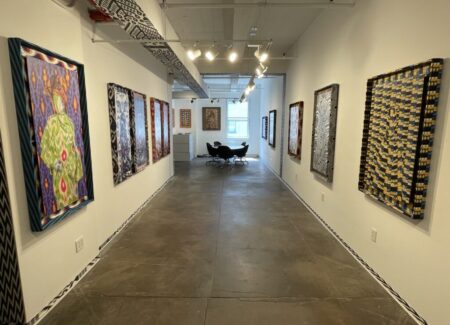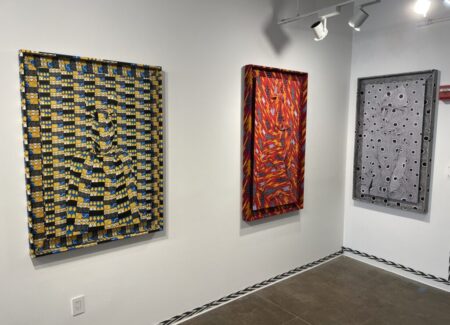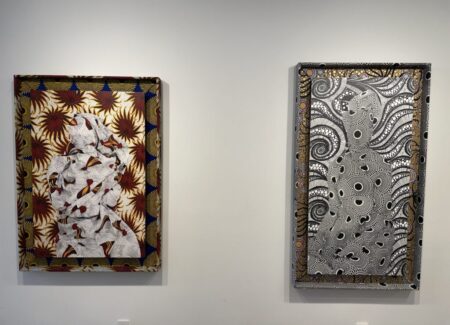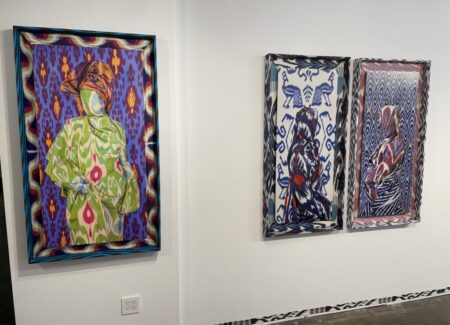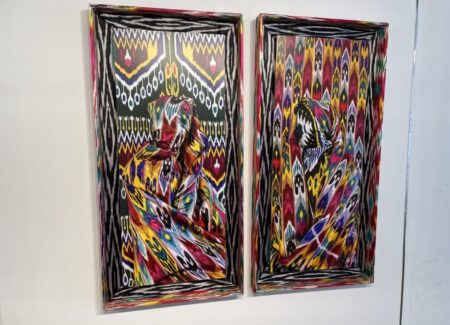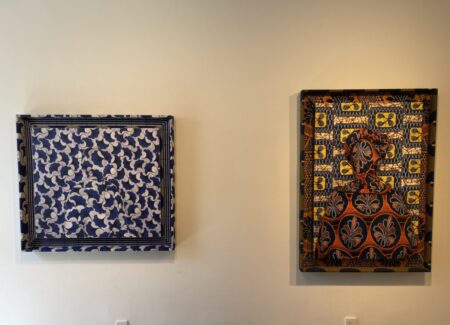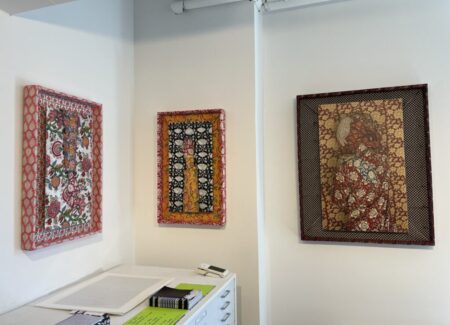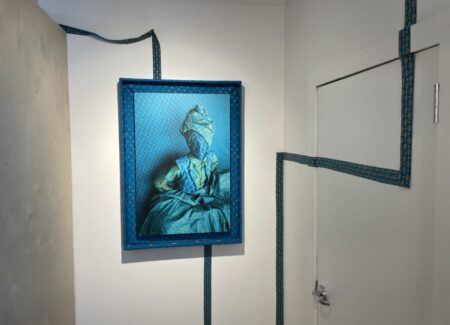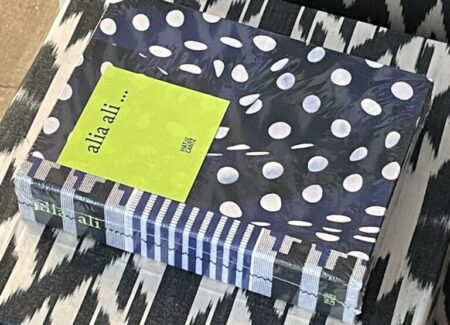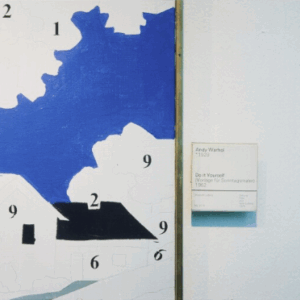JTF (just the facts): A total of 16 color photographic works, hung against white walls in the main gallery space. All of the works are pigment prints mounted on Dibond in wooden frames hand upholstered in various fabrics, including Dutch wax prints sourced from Senegal, Ivory Coast, and Nigeria, Rajasthani hand-printed cotton (with gold leaf), and Uzbek cotton and silk blend ikat, made in 2019, 2021, 2023, or 2024. Physical sizes range from roughly 34x21x3 to 63x39x3, and the works are available in editions of 5 or unique. (Installation shots below.)
A monograph of this body of work (titled One of Many) was published in 2024 by Hatje Cantz (here). Hardcover, 178 x 236 mm, 512 pages. Includes texts/essays by Allison Young, Zan Zeller, and the artist. (Cover shot below.)
Comments/Context: Given the richness of the cultural associations and personal memories embedded in different kinds of textiles made around the world, it’s not entirely surprising that these fabrics have become central participants in the work of a whole cohort of contemporary artists. The practice of including (or leveraging) resonant textiles has become so widespread – drawing in a diverse selection of artists like Yinka Shonibare, Stephanie Syjuco, Joiri Minaya, Thandiwe Muriu, Rachel Perry Welty, Keisha Scarville, Mickalene Thomas, Lyle Ashton Harris, and indeed many others – that it’s probably time for some enterprising curator to craft a survey of these textile-focused efforts and to draw some larger conclusions about how fabrics are being thoughtfully used by photographers, both physically and conceptually.
While textiles and their patterns and designs can of course be employed as decorative backdrops and clothing in photographic setups, one repeated approach of late has been to obscure human figures underneath, behind, or wrapped in particular fabrics, thereby masking their individual identities with specific textiles that carry important histories, meanings, or significance. And this is the central technique used by Alia Ali in a range of recent projects, as seen in the Yemeni-Bosnian-American artist’s show “Glitzsch”.
This one-room show covers quite a bit of artistic ground in a small space, gathering together a selection of Ali’s works made over the past handful of years, dipping into a number of different projects. One of the most recent works in the show, “Echo” from 2024, is part of the titular “Glitzsch” series, and provides a succinct introduction to Ali’s aesthetics. From afar, this work dissolves into a uniform pattern of interlocked blue and black leaves, as seen in a Dutch wax print textile found by the artist in Nigeria. But up close, that visual simplicity is revealed to be more complex, both in the discovery that the frame itself has been embroidered in the same fabric used in the photograph (at relatively the same scale), and in the slow resolving of a hidden figure wrapped in the patterned cloth and set against a backdrop of the same material, making the figure almost invisible. The “glitch” (with the added z) reference leads us to a particular set of thoughts and associations – to digital errors and mistakes, to visual disruptions, and to the immersive duality of a digital existence, as seen in a ghostly figure that floats in and out of recognizability. When we then place the shifting hooded figure in the context of the Dutch print and its colonial, imperial, and diasporic associations, that same glitch takes on other historical meanings and variations of identity.
This deliberate illusionism stands at the heart of Ali’s aesthetics, making invisibility, concealment, hiding in plain sight, veiling, inclusion/exclusion, and other wrapped, bundled, silenced, and mummified themes the basis for discrete sets of pictures. In some cases, there is a direct match between the fabrics wrapping the figures and those used as backgrounds (making the illusion the most difficult to detect), while in others two or three different textiles are used in harmony, adding frictions, contrasts, twists of pattern orientation, and color echoes to the compositional process. And in many cases, subtleties of pose are still visible underneath the wrappings, offering hints to personalities otherwise obscured.
Some of this nuance is inevitably overpowered by the bold vibrancy of many of the textiles Ali has chosen. Motifs of eye-popping lightning bolts, exuberant flowers, concentric dots, dense geometric patterns, and tentacle-like swirls seem to jump off the walls, demanding attention, with other more muted patters of flowers requiring a bit more patience to absorb. In the end, though, the embedded histories in the textiles, and the geographies they originate from, add complexity to the stories of invisibility Ali is telling – when a body is wrapped in Indian-print Liberty cotton, or woven Uzbek ikat, or boldly graphic Dutch wax print, it is inherently suffocated in the cultures (and conflicts) that specific fabric represents.
Given the big energy flowing out from these vibrantly patterned works, it’s perhaps easy to get lost in their decorativeness and leave it at that. But the strongest of Ali’s works create more tension that just the simple illusionism of a figure in textile patterns – they offer an open-ended opportunity to place ourselves in that silenced person’s place or to identify with the forces that have trapped them inside particular cultural, social, political, or even economic constraints. When we can get underneath the visual noise of the textiles and get at the potentials of self submerged there, that’s when Ali’s work becomes more durably intriguing.
Collector’s POV: The works in this show are priced between $8000 and $24000 each, based on size and place in the edition. Ali’s work has little secondary market history at this point, so gallery retail likely remains the best option for those collectors interested in following up.
